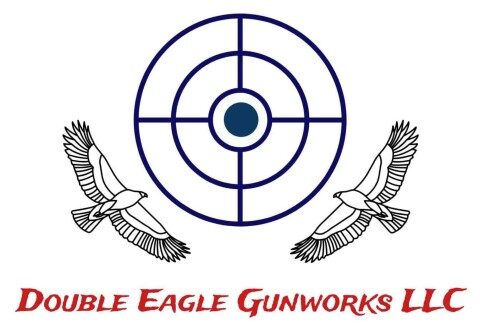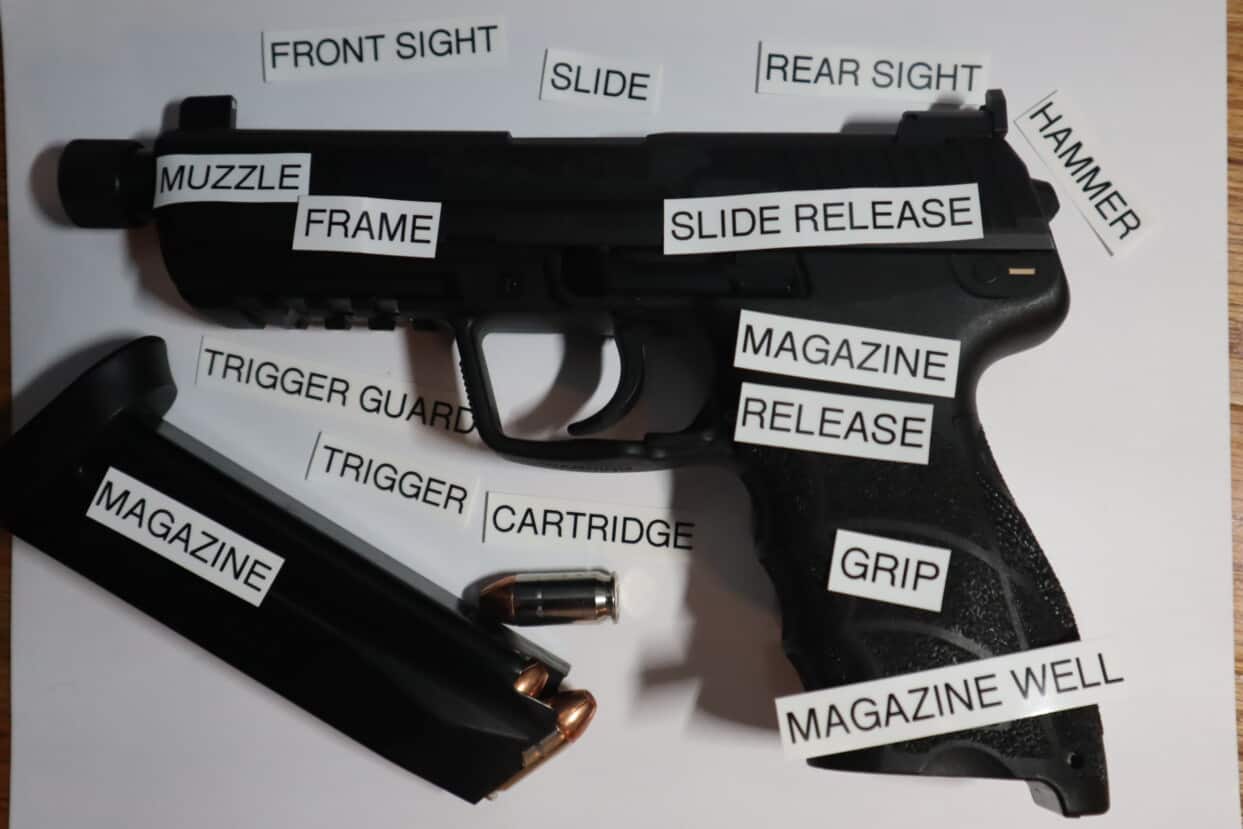Today we will learn the names of the parts and what they do.
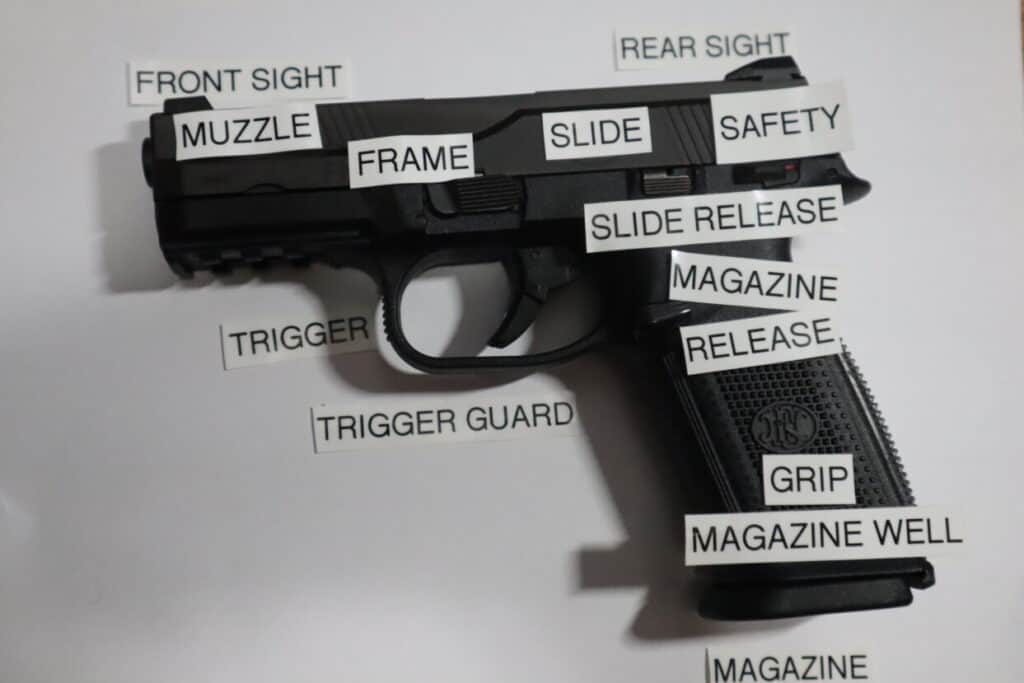
The semi-automatic pistol tends to be more streamlined than a revolver because it has no cylinder. It is more complex than a revolver and requires the user to have enough hand strength to rack the slide back.
Here’s a little background to help you understand the functions of the parts.
Striker Fired Versus Hammer Fired
There are two types of semi-automatic pistols: striker fired and hammer fired. The striker fired pistol in the first photo is the FN FNS-9.
A striker fired semi-auto has an internal striker which takes the place of the hammer. You rack the slide to cock the striker. After the first shot the slide cocks the striker as it chambers the next round.
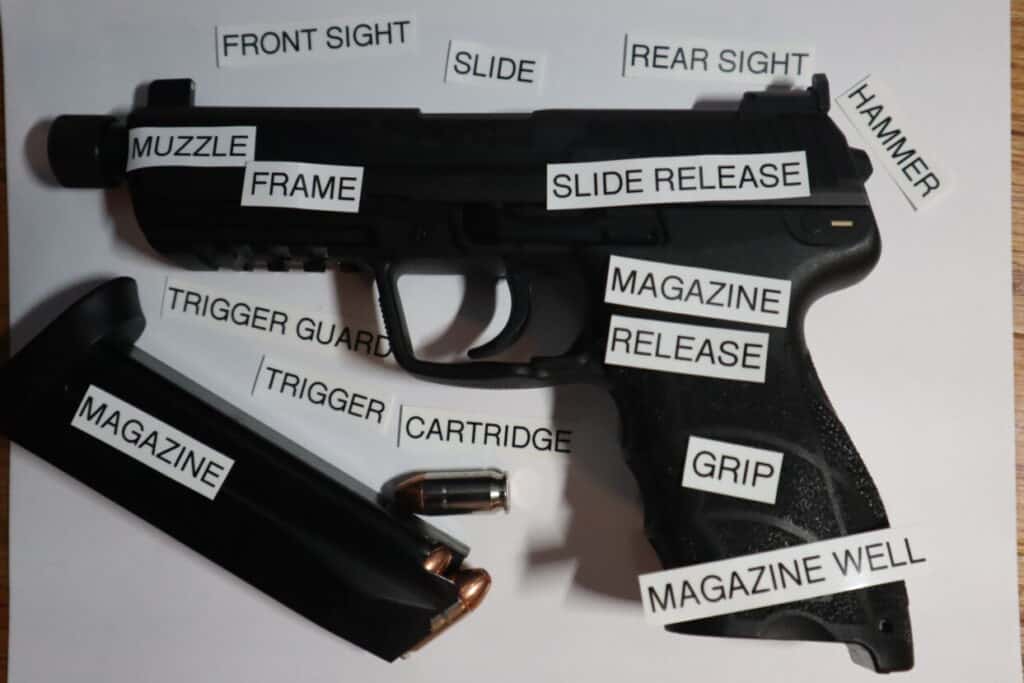
In the second photo we have the HK45 by Heckler and Koch, a hammer fired semi-automatic. Like a revolver, a hammer fired semi-auto can be single or double action.
Single Action Versus Double Action Hammer
With a single action semi-auto you must cock the hammer the first time you fire the gun, then the slide cocks the hammer as it chambers the next round.
With a double action/single action (DASA) pistol, you choose whether to cock the hammer yourself or let the trigger cock the hammer. The difference is in the trigger pull weight.
Cocking the hammer yourself decreases the work involved in pulling the trigger, giving you the ability to shoot more rounds without getting tired and compromising your shooting form.
A double action semi-automatic does not require you to cock the hammer before you pull the trigger.
Breaking it Down
Today we will break down the striker fired Sig Sauer P320. My husband uses the Sig for his everyday carry gun because he likes the larger grip and weightier feel of it in his hand.
Semi-automatics vary from model to model, but this will give you a basic overview. Refer to the labels above for the positions of the parts and the descriptions below for more details.
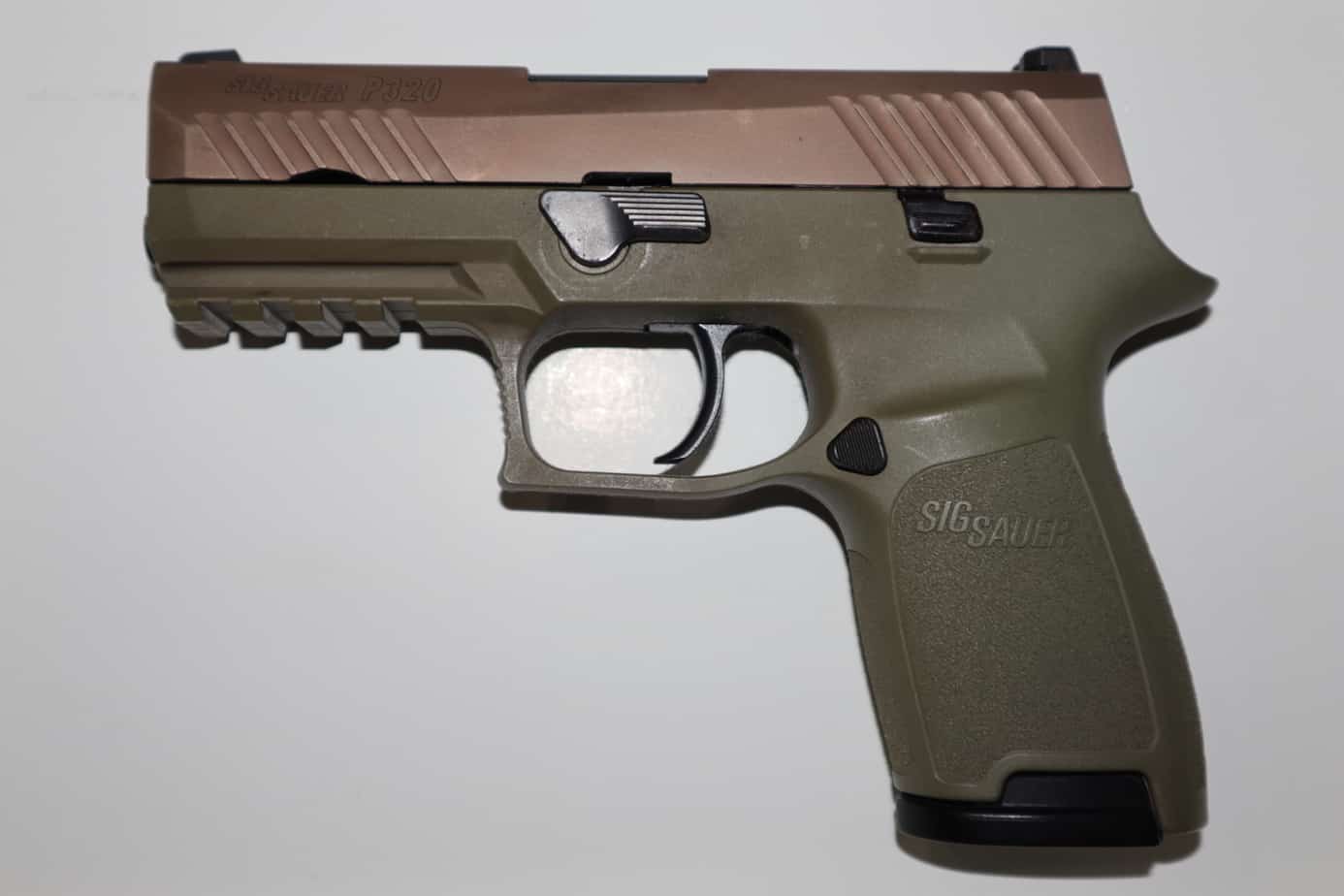
The Cartridge
With any gun, the cartridge is the case that contains the powder, the propellant, the primer, and the bullet. You will also hear it called a round.
The Magazine
The magazine is the accessory that holds the rounds. The one shown here holds thirteen rounds and is inserted into the magazine well from the bottom. The magazine well is built into the grip, which is the part you hold against the palm of your hand.
When you hear that a gun has a capacity of 13 +1 it means the magazine holds thirteen rounds and another round can be carried in the chamber, ready for shooting.
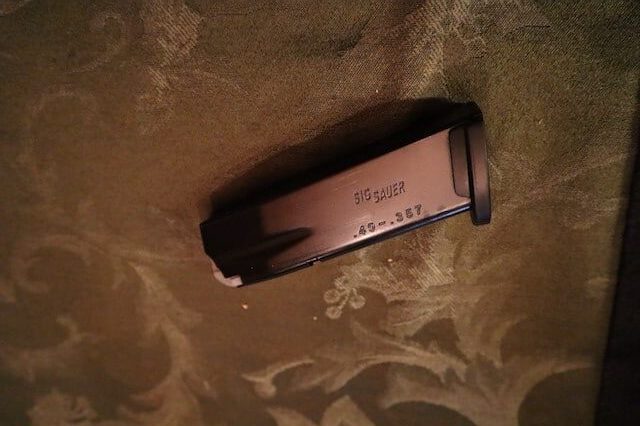
The Muzzle
The muzzle is the end of the barrel that you point at the target. Looking down the barrel of a gun is something to avoid. Practice good muzzle control and never point it at anything you are not willing to destroy.
Front and Rear Sights
You look between the rear sights and line up the front sight with your target. This is a popular area for upgrading, with brighter dots, larger posts, lights, and laser pointers.
The Frame
The frame is what the slide mounts on. The magazine fits into the frame and the slide rides on top.
The Slide
The slide holds the firing pin, the recoil spring, and the barrel. It cycles in a front to back motion when the gun is fired.
The extractor in the slide pulls out the empty case you just shot, then the slide strips the next round out of the magazine and loads it into the chamber.
You can see this round when you do a press check by pulling the slide back a little. The FN FNS-9 and some other semi-automatics have a visual indicator to show that a round is in the chamber.
After you load a magazine into an empty semi-automatic, you rack the slide by pulling it backward. When you release the slide it moves forward to seat the first round.
The extractor on the FNS-9 protrudes slightly and shows a little red mark when the chamber is loaded.
The Grip
The grip is the handle of the gun. You wrap your palm around the back part, called the backstrap, and then your thumb and fingers wrap around to the front.
The part of the grip that meets the web between your thumb and forefinger is the dovetail. It sticks out of the back like a duck bill.
Make sure the web between your thumb and forefinger is as high up on the grip as you can get it without interfering with the action of the slide to avoid being pinched when the slide racks back during shooting.
Your trigger finger needs to stay pointed alongside the frame until it is time to pull the trigger. In two handed shooting you wrap your supporting hand around the shooting hand on the grip
The Magazine Well
The magazine well is the hollow part of the handle where you insert the magazine. Once you have it in, tap the magazine to ensure proper placement.
The Magazine Release
The magazine release can be hard to find. In the hammer fired photo above it is integrated into the trigger guard. In the striker fired photo it is directly behind the trigger guard.
Both of these guns are entirely black. The Sig P320 pictured above is an excellent model because its black triangular magazine release stands out on the green grip just behind the trigger guard.
You may press in or pull a lever depending on the model of the gun. The magazine drops out the bottom of the grip.
Slide Release
Above and posterior to the magazine release is the slide release. This is what you press to allow the slide to move forward to load the next round in the chamber. In front of the slide release you will find the takedown lever, which you must rotate downward to remove the slide from the frame.
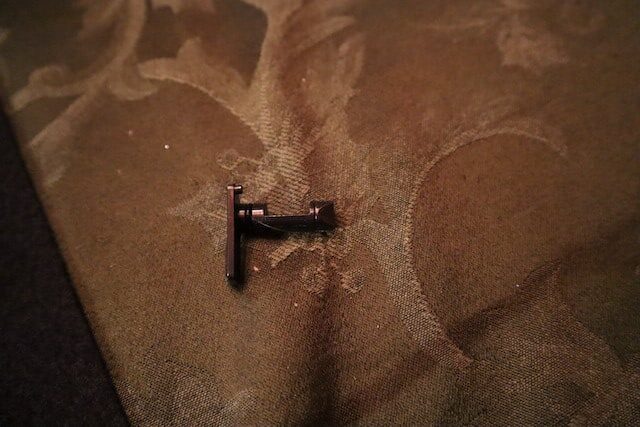
When the slide is locked all the way back, you have to activate the slide release to unlock the slide and let it go forward. On most semi-autos, the slide locks back to let you know when you have shot the last round.
The Barrel
The slide contains the barrel. The front of the barrel, where the bullet comes out, is the muzzle. The chamber that holds the bullet that will be shot next is the back part of the barrel.

The Grip Module
The bottom half of the gun is collectively called the grip module and it separates completely from the slide.
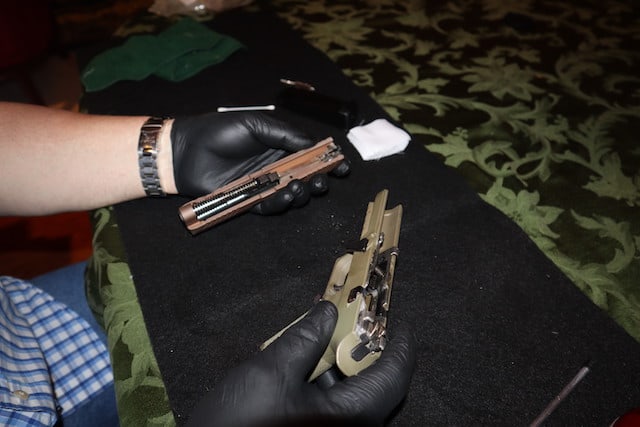
The Trigger Assembly
The trigger assembly can be removed from the Sig but not from all models of semi-automatic pistols. This is the part of the gun that is officially the gun according to the law, and this is where you will find the serial number.
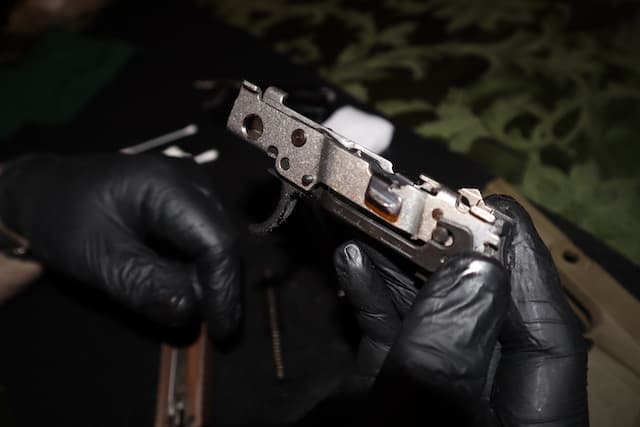
The Trigger Guard
The trigger is encased in an oval or circular cage called the trigger guard to keep you from shooting the gun accidentally. Keep your finger out of the trigger guard until you are ready to shoot.
The Trigger
The trigger is the part that hangs like a comma from the bottom of the trigger assembly. Pulling the trigger activates the action that shoots the gun.
The Hammer or the Striker
The FNS-9 is hammer fired. With a round in the chamber, you can pull the trigger. Without a round in the chamber, you must rack the slide, which is the moving metal piece on the top, to chamber a round before pulling the trigger.
Pulling the trigger activates the recoil spring, moving the hammer, which hits the firing pin, which hits the primer of the cartridge.
With a single-action gun, you cock the hammer manually before you pull the trigger. With a double action the hammer is cocked when you pull the trigger.
The P320 is striker fired, so it has no hammer. When you squeeze the trigger it releases the striker, which fires the cartridge, sending the bullet down the barrel.
When the bullet fires, the gases force the slide to the rear, which resets the striker. As the slide comes forward it chambers the next round.
The Recoil Spring
The recoil spring helps mitigate the force of recoil. Once the slide reaches the most rearward position, the recoil spring brings the slide back into battery.
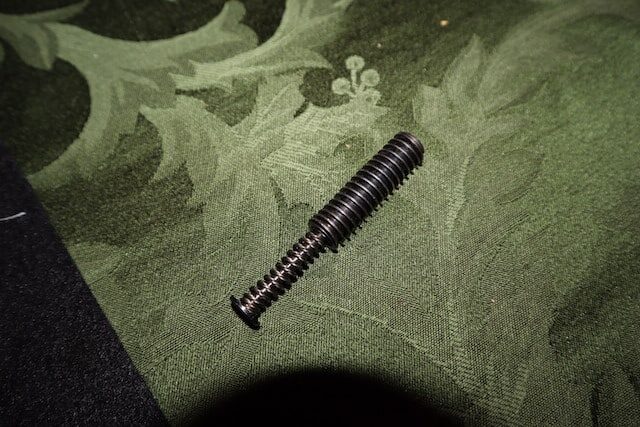
The Safety
The safety on the FNS-9 is the last latch at the rear of the slide. When it is activated with an upward push it keeps the slide from moving, thereby preventing the firing of the gun. When deactivated, a small red marker indicates that the gun can be fired.
Not all guns have a safety. The HK45 above does not have an external safety because the V7 trigger won’t fire until you pull it all the way back, and you have to rack the slide to cock the hammer. The P320 does not have a safety.
Putting It All Together
All the parts come together to make the gun shoot. Here is how it works:
- You pull the slide backward, which compresses the recoil spring
- You let go of the slide and the recoil spring pushes the slide forward
- As the slide moves forward, it catches the next round in the magazine and pushes it up the feed ramp into the chamber
- If it is a single action, you cock the hammer to move it into position
- You pull the trigger
- The trigger moves the hammer OR the striker
- The hammer hits the firing pin OR the striker hits the firing pin
- The firing pin hits the primer, setting up an explosion in the powder
- The gases from the explosion propel the bullet out of the barrel toward your target
- The slide moves backward, ejecting the spent casing
- The slide returns to the forward position, seating a new round
- You are ready to shoot again.
